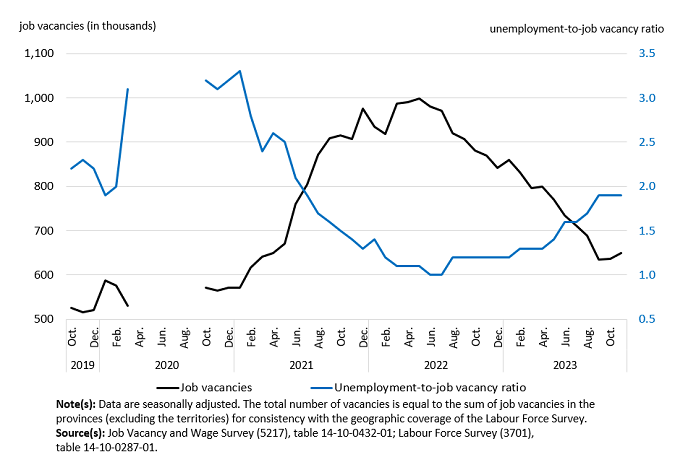Infographic 2
Unemployment-to-job vacancy ratio holds steady for three consecutive months

Infographic description
The title of the infographic is "Unemployment-to-job vacancy ratio holds steady for three consecutive months"
This is a linear chart.
The vertical axis on the left shows the number of job vacancies in thousands, by increments of 100,000. It starts at 500,000 and ends at 1,100,000.
The vertical axis on the right shows the unemployment-to-job vacancy ratio, by increments of 0.5. it starts at 0.5 and ends at 3.5.
The horizontal axis shows each month, from October 2019 to November 2023.
The black line represents the number of job vacancies (in thousands) in the last 50 months, with 549,200 in January 2019, 543,400 in February 2019, 545,400 in March 2019, 552,900 in April 2019, 553,100 in May 2019, 533,600 in June 2019, 530,300 in July 2019, 527,700 in August 2019, 513,900 in September 2019, 525,100 in October 2019, 515,200 in November 2019, 520,700 in December 2019, 587,500 in January 2020, 576,900 in February 2020, 531,200 in March 2020, April 2020 to September 2020 omitted because data were not collected during this phase of the COVID-19 pandemic, 572,100 in October 2020, 565,600 in November 2020, 570,700 in December 2020, 570,700 in January 2021, 616,800 in February 2021, 641,200 in March 2021, 650,400 in April 2021, 671,100 in May 2021, 761,000 in June 2021, 805,300 in July 2021, 871,400 in August 2021, 909,100 in September 2021, 916,200 in October 2021, 907,000 in November 2021, 975,700 in December 2021, 934,800 in January 2022, 918,400 in February 2022, 987,200 in March 2022, 990,100 in April 2022, 999,400 in May 2022, 981,100 in June 2022, 971,400 in July 2022, 920,100 in August 2022, 908,100 in September 2022, 881,600 in October 2022, 869,500 in November 2022, 842,700 in December 2022, 860,400 in January 2023, 831,700 in February 2023, 796,900 in March 2023, 799,900 in April 2023, 771,000 in May 2023, 734,600 in June 2023, 711,900 in July 2023, 688,700 in August 2023, 635,600 in September 2023, 636,200 in October 2023, and 650,200 in November 2023.
The blue line represents the unemployment-to-job vacancy ratio in the last 50 months, with 2.1 in January 2019, 2.1 in February 2019, 2.2 in March 2019, 2.1 in April 2019, 2.0 in May 2019, 2.1 in June 2019, 2.2 in July 2019, 2.2 in August 2019, 2.2 in September 2019, 2.2 in October 2019, 2.3 in November 2019, 2.2 in December 2019, 1.9 in January 2020, 2.0 in February 2020, 3.1 in March 2020, April 2020 to September 2020 omitted because data were not collected during this phase of the COVID-19 pandemic, 3.2 in October 2020, 3.1 in November 2020, 3.2 in December 2020, 3.3 in January 2021, 2.8 in February 2021, 2.4 in March 2021, 2.6 in April 2021, 2.5 in May 2021, 2.1 in June 2021, 1.9 in July 2021, 1.7 in August 2021, 1.6 in September 2021, 1.5 in October 2021, 1.4 in November 2021, 1.3 in December 2021, 1.4 in January 2022, 1.2 in February 2022, 1.1 in March 2022, 1.1 in April 2022, 1.1 in May 2022, 1.0 in June 2022, 1.0 in July 2022, 1.2 in August 2022, 1.2 in September 2022, 1.2 in October 2022, 1.2 in November 2022, 1.2 in December 2022, 1.2 in January 2023, 1.3 in February 2023, 1.3 in March 2023, 1.3 in April 2023, 1.4 in May 2023, 1.6 in June 2023, 1.6 in July 2023, 1.7 in August 2023, 1.9 in September 2023, 1.9 in October 2023, and 1.9 in November 2023.
Note(s): Data are seasonally adjusted. The total number of vacancies is equal to the sum of job vacancies in the provinces (excluding the territories) for consistency with the geographic coverage of the Labour Force Survey. Job Vacancy and Wage Survey data collection was suspended from April 2020 to September 2020. Therefore, data for these reference periods are not available.
Source(s): Job Vacancy and Wage Survey (5217), table 14-10-0432-01; Labour Force Survey (3701), table 14-10-0287-01.
- Date modified: